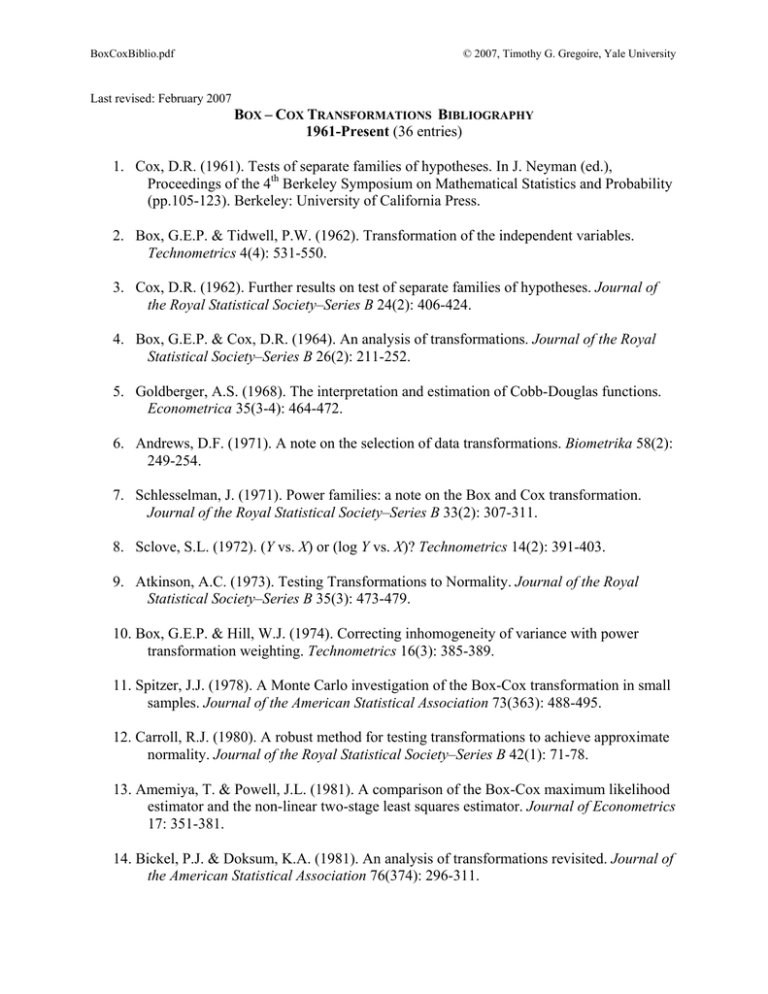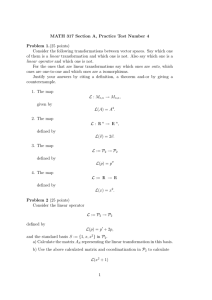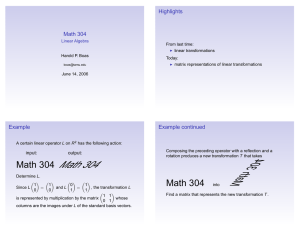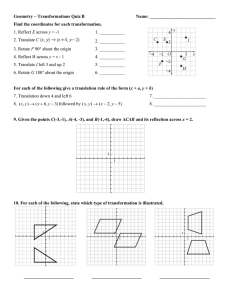1. Cox, D.R. (1961). Tests of separate families of... Proceedings of the 4 B
advertisement

BoxCoxBiblio.pdf © 2007, Timothy G. Gregoire, Yale University Last revised: February 2007 BOX – COX TRANSFORMATIONS BIBLIOGRAPHY 1961-Present (36 entries) 1. Cox, D.R. (1961). Tests of separate families of hypotheses. In J. Neyman (ed.), Proceedings of the 4th Berkeley Symposium on Mathematical Statistics and Probability (pp.105-123). Berkeley: University of California Press. 2. Box, G.E.P. & Tidwell, P.W. (1962). Transformation of the independent variables. Technometrics 4(4): 531-550. 3. Cox, D.R. (1962). Further results on test of separate families of hypotheses. Journal of the Royal Statistical Society–Series B 24(2): 406-424. 4. Box, G.E.P. & Cox, D.R. (1964). An analysis of transformations. Journal of the Royal Statistical Society–Series B 26(2): 211-252. 5. Goldberger, A.S. (1968). The interpretation and estimation of Cobb-Douglas functions. Econometrica 35(3-4): 464-472. 6. Andrews, D.F. (1971). A note on the selection of data transformations. Biometrika 58(2): 249-254. 7. Schlesselman, J. (1971). Power families: a note on the Box and Cox transformation. Journal of the Royal Statistical Society–Series B 33(2): 307-311. 8. Sclove, S.L. (1972). (Y vs. X) or (log Y vs. X)? Technometrics 14(2): 391-403. 9. Atkinson, A.C. (1973). Testing Transformations to Normality. Journal of the Royal Statistical Society–Series B 35(3): 473-479. 10. Box, G.E.P. & Hill, W.J. (1974). Correcting inhomogeneity of variance with power transformation weighting. Technometrics 16(3): 385-389. 11. Spitzer, J.J. (1978). A Monte Carlo investigation of the Box-Cox transformation in small samples. Journal of the American Statistical Association 73(363): 488-495. 12. Carroll, R.J. (1980). A robust method for testing transformations to achieve approximate normality. Journal of the Royal Statistical Society–Series B 42(1): 71-78. 13. Amemiya, T. & Powell, J.L. (1981). A comparison of the Box-Cox maximum likelihood estimator and the non-linear two-stage least squares estimator. Journal of Econometrics 17: 351-381. 14. Bickel, P.J. & Doksum, K.A. (1981). An analysis of transformations revisited. Journal of the American Statistical Association 76(374): 296-311. BoxCoxBiblio.doc © 2007, Timothy G. Gregoire, Yale University 15. Box, G.E.P. & Cox, D.R. (1982). An analysis of transformations revisited, rebutted. Journal of the American Statistical Association 77(377): 209-210. 16. Guerrero, V.M. & Johnson, R.A. (1982). Use of the Box-Cox transformation with binary response models. Biometrika 69(2): 309-314. 17. Hinkley, D.V. & Runger, G. (1984). The analysis of transformed data. Journal of the American Statistical Association 79(386): 302-320. 18. Davidson, R. & MacKinnon, J.G. (1985). Testing linear and loglinear regressions against Box-Cox alternatives. Canadian Journal of Economics XVIII(3): 499-517. 19. Taylor, J.M.G. (1985a). Measures of location of skew distributions obtained through Box-Cox transformations. Journal of the American Statistical Association 80(390): 427-432. 20. Taylor, J.M.G. (1985b). Power transformations to symmetry. Biometrika 72(1): 145-152. 21. Geisser, S. (1986). Opera Selecta Boxi. Statistical Science 1(1): 106-113. 22. Taylor, J.M.G. (1986). The retransformed mean after a fitted power transformation. Journal of the American Statistical Association 81(393): 114-118. 23. Perry, J.N. (1987). Iterative improvement of a power transformation to stabilize variance. Applied Statistics 36(1): 15-21. 24. Taylor, J.M.G. (1989). A note on the cost of estimating the ratio of regression parameters after fitting a power transformation. Journal of Statistical Planning and Inference 21: 223-230. 25. Sakia, R.M. (1990). Retransformation bias: a look at the Box-Cox transformation to linear balanced mixed ANOVA models. Metrika 37: 345-351. 26. Stoline, M.R. (1991). An examination of the lognormal and Box and Cox family of transformations in fitting environmental data. Environmetrics 2(1): 85-106. 27. Sakia, R.M. (1992). The Box-Cox transformation technique: a review. The Statistician 41: 169-178. 28. Wooldridge, J.M. (1992). Some alternatives to the Box-Cox regression model. International Economic Review 33(4): 935-955. 29. Velleman, P. (1993). Email regarding “Fallacies & Transformat (sic)” 30. Edwards, L.J. & Hamilton, S.A. (1995). Errors-in-variables and the Box-Cox transformation. Computational Statistics & Data Analysis 20: 131-140. 2 BoxCoxBiblio.doc © 2007, Timothy G. Gregoire, Yale University 31. Kim, M. & Hill, R.C. (1995). Shrinkage estimation in nonlinear regression: The Box-Cox transformation. Journal of Econometrics 66: 1-33. 32. Sakia, R.M. (1995). An empirical comparison of three bias estimating procedures due to retransformation. Informatik, Biometrie und Epidemiologie in Medizin und Biologie 26(1): 1-6. 33. Taylor, R.M.G., Siqueira, A.L. and Weiss, R.E. (1996). The cost of adding parameters to a model. Journal of the Royal Statistical Society–Series B 58(3): 593-607. 34. Lipsitz, S.R. (2000). Using a Box-Cox transformation in the analysis of longitudinal data with incomplete responses. Applied Statistics 49(2): 287-296. 35. Riani, M. & Atkinson, A.C. (2000). Robust diagnostic data analysis: transformations in regression. Technometrics 42(4): 1-11. 36. Cook, R.D. & Olive, D.J. (2001). A note on visualizing response transformations in regression. Technometrics 43(4): 443-449. 3





